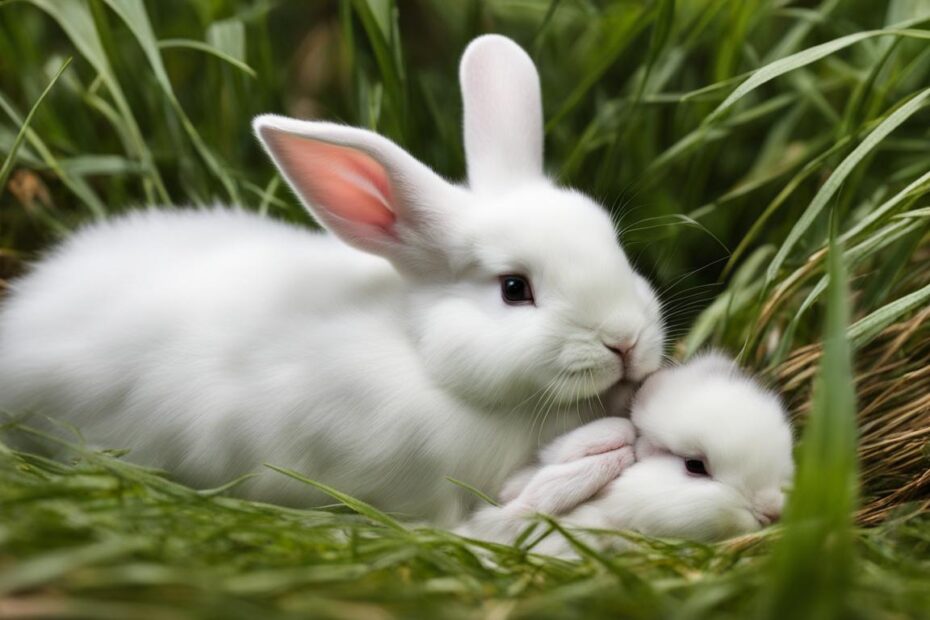Have you ever wondered if bunnies are born with fur? In this article, we will explore the fascinating world of bunny birth and the growth of their adorable fur. Prepare to be amazed by these little bundles of fluff!
Key Takeaways:
- Baby rabbits, known as kits, are born without fur.
- Their fur starts to grow within the first few days after birth.
- The mother rabbit plays a crucial role in nest-building and maternal care.
- The lack of fur at birth is natural and essential for their development.
- Unnecessary handling or disturbance of baby rabbits should be avoided.
Bunny Birth and Fur Growth Process
Baby rabbits, known as kits, are born without fur. Their fur starts to grow within the first few days after birth. The growth of fur in baby rabbits is a gradual process, and it usually takes a few weeks for them to develop a full coat. During this time, the kits rely on their mother’s warmth and protection to survive.
The development of fur in baby rabbits is an important milestone in their early life. As their fur grows, it provides insulation and protection against the environment. It helps regulate their body temperature and keeps them warm during colder days. The fur also helps camouflage them in their surroundings, making it easier to hide from potential predators.
Fur growth in baby rabbits follows a specific pattern. It typically starts from the head and gradually spreads to the rest of their bodies. At first, the fur appears thin and sparse, but it becomes denser and thicker as the kits grow older. By the time they reach a few weeks of age, they usually have a complete coat of fur, ready to explore the world outside their nest.
Understanding the process of bunny birth and fur growth is fascinating and essential for anyone interested in these adorable creatures. It highlights the remarkable adaptations that enable baby rabbits to survive and thrive in the wild. Let’s explore further to appreciate the intricate journey of bunny birth and fur development.
Bunny Coat at Birth
When bunnies are born, they have no fur on their bodies. They are completely hairless and rely on their mother’s body heat to stay warm. The lack of fur at birth is a natural characteristic of newborn rabbits and is essential for their development.
Unlike some other mammals, bunnies do not have a layer of fur to protect them from the elements when they are born. Instead, they depend on their mother to provide warmth and create a safe environment for them to grow. The absence of fur at birth allows the kits to have direct contact with their mother’s body, ensuring they receive the necessary heat and protection.
Over time, as the baby rabbits develop and grow, their fur starts to emerge. It is a gradual process that takes place over the course of a few weeks. Initially, the fur appears as a thin layer of fine hair, and as the kits continue to mature, it becomes thicker and denser. The growth of fur is a crucial stage in their development, as it helps them regulate their body temperature and provides insulation from the external environment.
Bunny Coat Characteristics
When examining the fur of newborn rabbits, several characteristics can be observed. The fur of baby bunnies is typically soft and delicate to the touch. It often has a lighter color compared to the fur of adult rabbits, and it may appear slightly different in texture. Additionally, the fur on newborn rabbits is not as dense as that of older rabbits, allowing some parts of their skin to be visible through the fur.
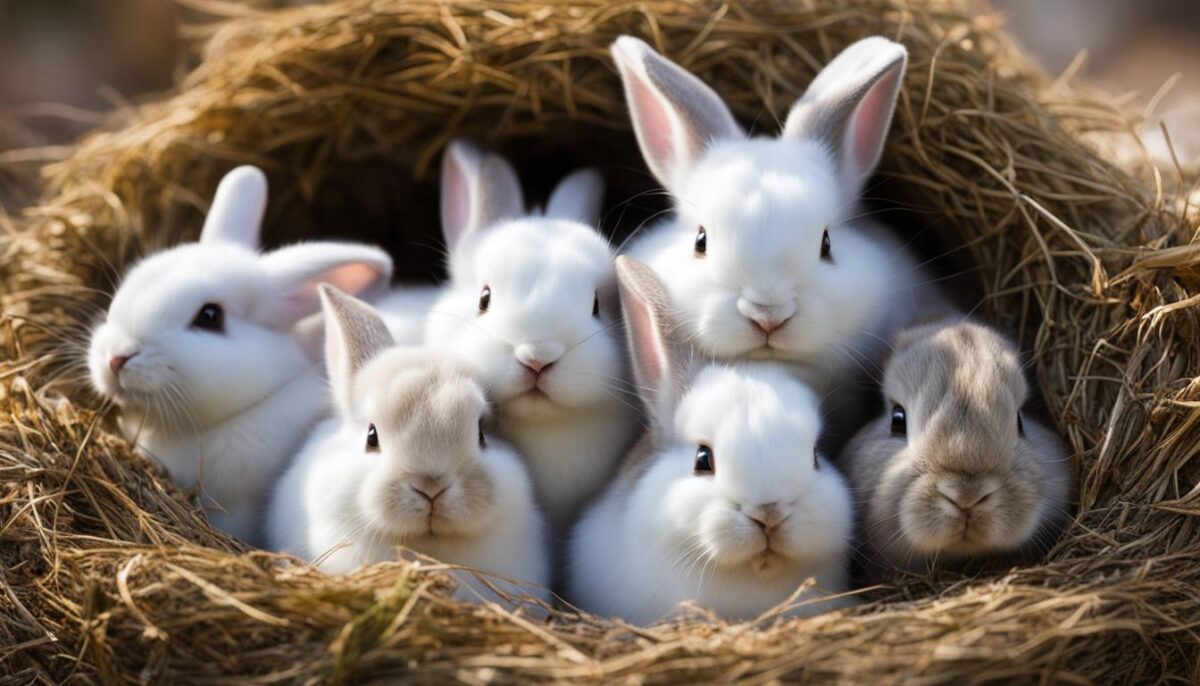
As the kits continue to grow and develop, their fur gradually changes in color and texture. It becomes more similar to the fur of adult rabbits, providing better camouflage and protection. The transformation of their coat is a fascinating process that highlights the resilience and adaptability of these adorable creatures.
Nest Building and Maternal Care
Nest building and maternal care are essential aspects of a rabbit’s reproductive behavior. Female rabbits, known as does, exhibit remarkable instincts when it comes to creating safe and comfortable spaces for their offspring. Let’s explore the fascinating process of nest building and the vital role of maternal care in ensuring the survival of baby rabbits.
Nest Building
When preparing for the arrival of her kits, a pregnant doe will start digging a nest in the ground. The nest provides protection from predators and helps regulate the temperature for the vulnerable newborns. The doe meticulously selects a suitable location and uses her front paws to dig a shallow burrow. Once the burrow is complete, she lines it with soft materials such as grass, leaves, or her own fur.
Maternal Care
Maternal care is crucial for the survival and development of baby rabbits. The doe takes on the responsibility of nursing, grooming, and protecting her kits. She provides nourishment through milk, which is essential for their growth and immune system development. The doe also keeps the nest clean by consuming the kits’ waste to minimize the chances of attracting predators.
The mother rabbit displays an interesting behavior called “absentee-maternal care.” She spends minimal time in the nest to avoid drawing attention to her offspring and potentially attracting predators. This natural instinct helps ensure the safety of the kits while allowing the mother to focus on finding food and staying alert to potential dangers.
| Benefits of Nest Building and Maternal Care | Impact on Kit Survival |
|---|---|
| Provides a safe and warm environment | Increases chances of survival |
| Protects against predators | Reduces vulnerability |
| Fosters bonding between mother and kits | Enhances overall well-being |
Nest building and maternal care in rabbits highlight the remarkable nurturing instincts of these animals. Through their actions, female rabbits create a nurturing environment that promotes the survival and growth of their offspring, ensuring the continuation of their species.
Importance of Fur in Nest Building
The female rabbit plays a crucial role in the nesting process by utilizing her own fur. She plucks fur from various parts of her body, excluding the abdomen, to create a warm and cozy bed for her kits. This fur lining serves as insulation and provides the necessary warmth and protection for the newborn rabbits.
The fur acts as a natural barrier against the elements, helping to regulate the kits’ body temperature and keeping them comfortable during their early development. It also helps to absorb moisture and provides a soft surface for the babies to lie on, ensuring their comfort and well-being in the nest.
“The female rabbit carefully selects and arranges the fur, creating a secure environment for her kits,” explains Dr. Jane Reynolds, a wildlife biologist. “The fur lining not only provides warmth but also helps to mask the scent of the babies, making them less detectable to potential predators.”
The role of fur in nest building
- Insulation: The fur lining acts as insulation, providing warmth and protection for the newborn rabbits.
- Moisture absorption: The fur helps to absorb moisture, keeping the nest dry and comfortable for the kits.
- Scent masking: The fur helps to mask the scent of the babies, making them less detectable to predators.
The importance of fur in nest building cannot be overstated. It plays a vital role in creating a safe and nurturing environment for the baby rabbits, allowing them to grow and develop in the early stages of their lives.
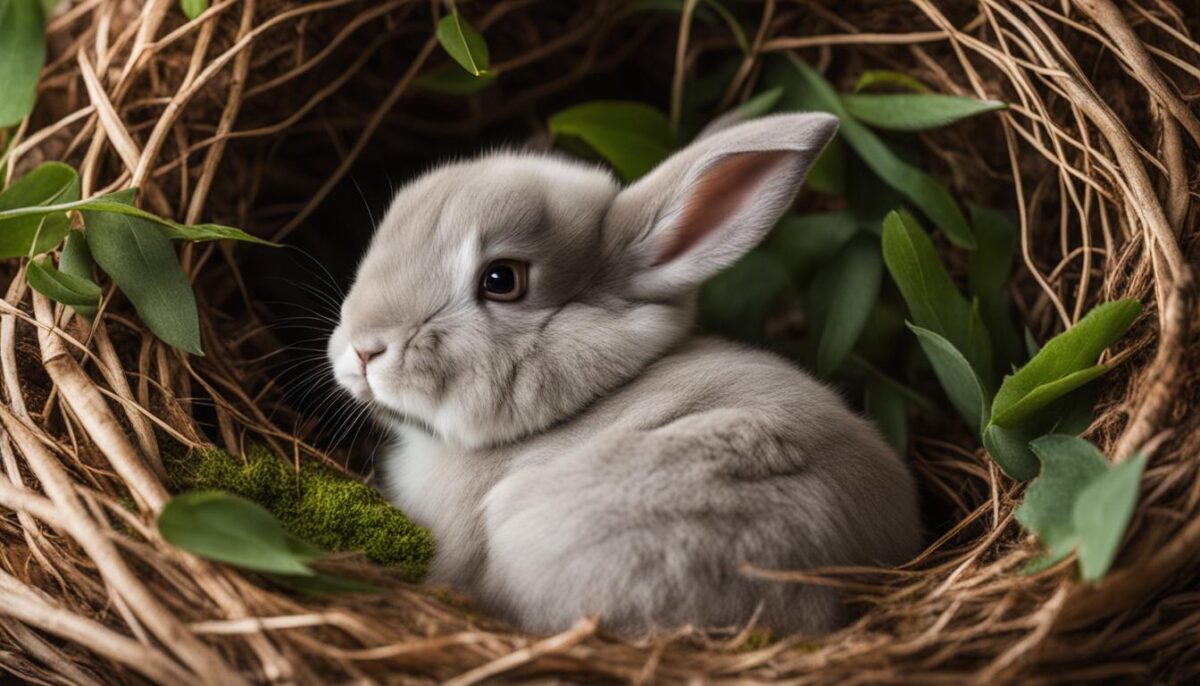
Nest Maintenance and Protection
Keeping the nest clean and ensuring the safety of young rabbits are vital tasks for the mother rabbit. Nest maintenance involves several activities that contribute to the well-being of the newborn kits. The mother covers the nest with grass or other materials to provide additional insulation and camouflage while she goes out to find food. This protective measure helps to keep the young rabbits safe from predators and unfavorable weather conditions.
The mother rabbit plays a vigilant role in protecting her offspring. She keeps a watchful eye over the nest and only returns during nursing times to minimize the risk of attracting predators. By staying away from the nest as much as possible, the mother reduces the chances of her scent leading predators to the location of her vulnerable kits. This absentee-maternal care system ensures that the young rabbits have the best chance of survival in their early days.
“The mother rabbit covers the nest with grass and only returns during nursing times to protect her kits from predators. This absentee-maternal care system is a natural instinct to ensure the survival of the young rabbits.”
The nest is used for approximately two weeks until the babies develop the necessary mobility and survival skills to venture out on their own. During this time, the mother rabbit’s diligent nest maintenance and protective behavior contribute significantly to the survival and well-being of her young. Understanding these natural behaviors helps us appreciate the remarkable strategies that rabbits employ to ensure the successful birth and growth of their offspring.
Table: Nest Maintenance and Protection Activities
| Activity | Description |
|---|---|
| Covering the nest | The mother rabbit covers the nest with grass or other materials to provide insulation and camouflage, protecting the young rabbits from predators and unfavorable weather conditions. |
| Absentee-maternal care | The mother stays away from the nest as much as possible to minimize the risk of attracting predators. She only returns during nursing times to feed and care for her kits. |
| Nest usage duration | The nest is used for approximately two weeks until the young rabbits develop enough mobility and survival skills to leave the nest and explore their surroundings. |
Bunny Birth Mortality Rate and the Survival of Newborn Rabbits
During the first two weeks of their lives, newborn rabbits face a relatively high mortality rate. Various factors contribute to this vulnerability, including exposure, starvation, drowning, and disease. Understanding the challenges these tiny creatures face and the importance of their mother’s care and fur development can help ensure their survival.
As mentioned in the previous sections, baby bunnies are born without fur and rely on their mother’s warmth and protection. The gradual growth of their fur provides crucial insulation against the elements and helps regulate their body temperature. Without a sufficient coat, newborn rabbits are more susceptible to cold stress, which can lead to hypothermia and ultimately, death.
The mortality rate of newborn rabbits can also be influenced by their environment. Exposure to extreme temperatures, especially in the absence of a warm nest, can be fatal. Additionally, insufficient nutrition and lack of access to their mother’s milk can lead to malnourishment and weakened immune systems, making them more susceptible to diseases and infections.
| Factors Contributing to Bunny Birth Mortality Rate | Potential Consequences |
|---|---|
| Inadequate fur development | Increased vulnerability to cold stress and hypothermia |
| Exposure to extreme temperatures | Risk of hypothermia or heat exhaustion |
| Insufficient nutrition | Malnourishment, weakened immune system, susceptibility to diseases |
| Lack of maternal care | Decreased chances of survival due to abandonment or inadequate protection |
The survival of newborn rabbits greatly depends on the care provided by their mother. The attentive nest-building, frequent nursing visits, and vigilant protection from predators are essential for the kits’ well-being. The development of their fur provides the necessary insulation and protection, enhancing their chances of survival during this vulnerable period.
By understanding the challenges faced by newborn rabbits and the significance of their mother’s care and fur development, we can appreciate the delicate balance of nature and the resilience of these adorable creatures.
Absentee-Maternal Care System of Rabbits
Rabbits practice an absentee-maternal care system, where the mothers stay away from their kits as much as possible. After giving birth, the mother leaves the nest and returns infrequently to avoid attracting predators. This behavior is a natural instinct to protect the offspring.
In this unique care system, the mother rabbit’s behavior plays a crucial role in the survival of the kits. By minimizing her presence around the nest, she reduces the risk of drawing attention to her vulnerable offspring. Instead, she relies on her keen senses to monitor the area from a safe distance.
This absentee-maternal care system demonstrates the extraordinary adaptability of rabbits in ensuring the safety of their young. By strategically limiting direct contact and minimizing the scent left around the nest, mother rabbits enhance the chances of their kits’ survival. It is a fascinating example of nature’s ingenious strategies for the protection of offspring.
The Importance of the Absentee-Maternal Care System
The absentee-maternal care system of rabbits is essential for the survival of the kits. By staying away from the nest, the mother rabbit effectively reduces the likelihood of attracting predators. This behavior not only safeguards her offspring but also allows the kits to develop their own survival skills in a safe environment.
| Benefits of Absentee-Maternal Care System | Risks of Absentee-Maternal Care System |
|---|---|
|
|
While the absentee-maternal care system presents certain risks, such as potential separation anxiety and increased vulnerability to extreme weather, the long-term benefits outweigh them. By allowing the kits to develop independence and instinctual behaviors early on, they are better equipped to thrive in their natural habitat.
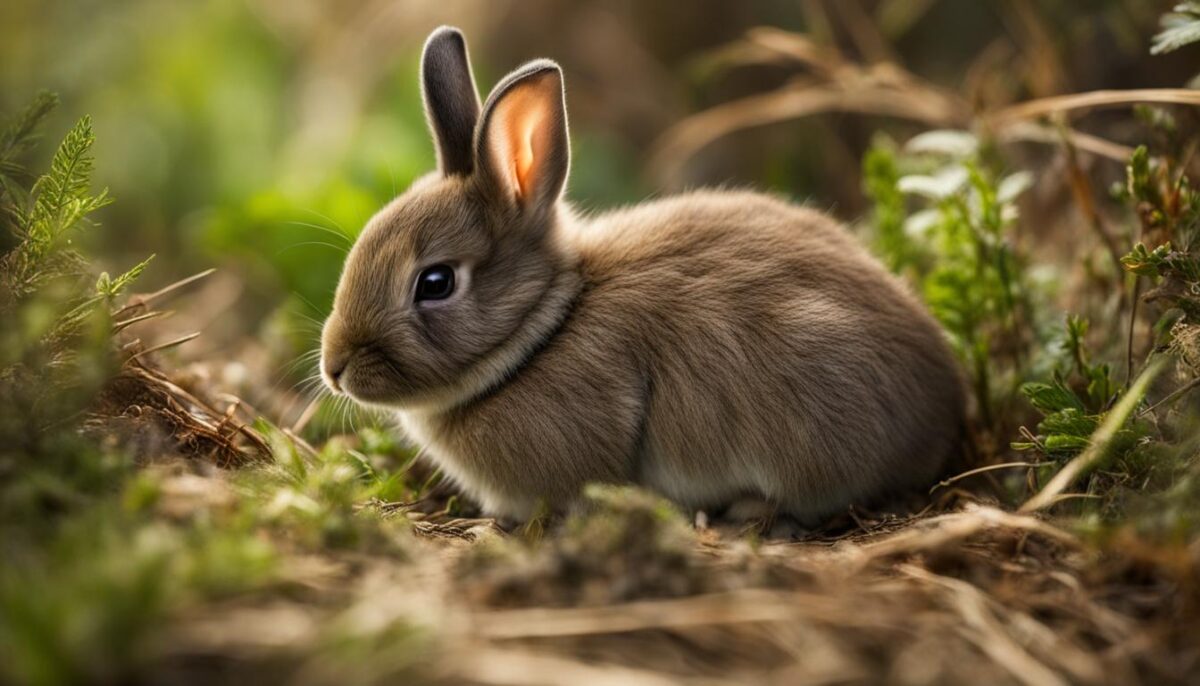
Interaction with Baby Rabbits
When it comes to handling newborn bunnies, it’s important to exercise caution and minimize unnecessary interaction. Newborn rabbits are highly vulnerable, and disturbing them can disrupt their mother’s care and potentially lead to abandonment. If you come across a nest or individual kits, it’s best to leave them alone and observe from a distance.
The mother rabbit practices an absentee-maternal care system, where she stays away from the nest as much as possible to protect her offspring from predators. Handling the baby rabbits can leave behind human scent, which may attract unwanted attention. It’s crucial to respect the natural instincts of the mother rabbit and allow her to care for her kits undisturbed.
Remember, baby rabbits are delicate and require specialized care. If you suspect that a baby rabbit is in immediate danger or injured, it’s recommended to contact a local wildlife rehabilitator or veterinarian for guidance. They have the expertise and resources to provide the necessary care and ensure the best chance of survival for these adorable creatures.
Tips for Interacting with Baby Rabbits:
- Avoid touching or moving baby rabbits if possible.
- Observe from a safe distance to minimize disturbance.
- Do not try to feed or provide care unless directed by a professional.
- If you notice any signs of distress or injury, seek assistance from a wildlife rehabilitator or veterinarian.
By understanding the importance of minimal interaction with baby rabbits, we can contribute to their well-being and survival. Let nature take its course and trust in the instincts of these remarkable creatures to care for their young.
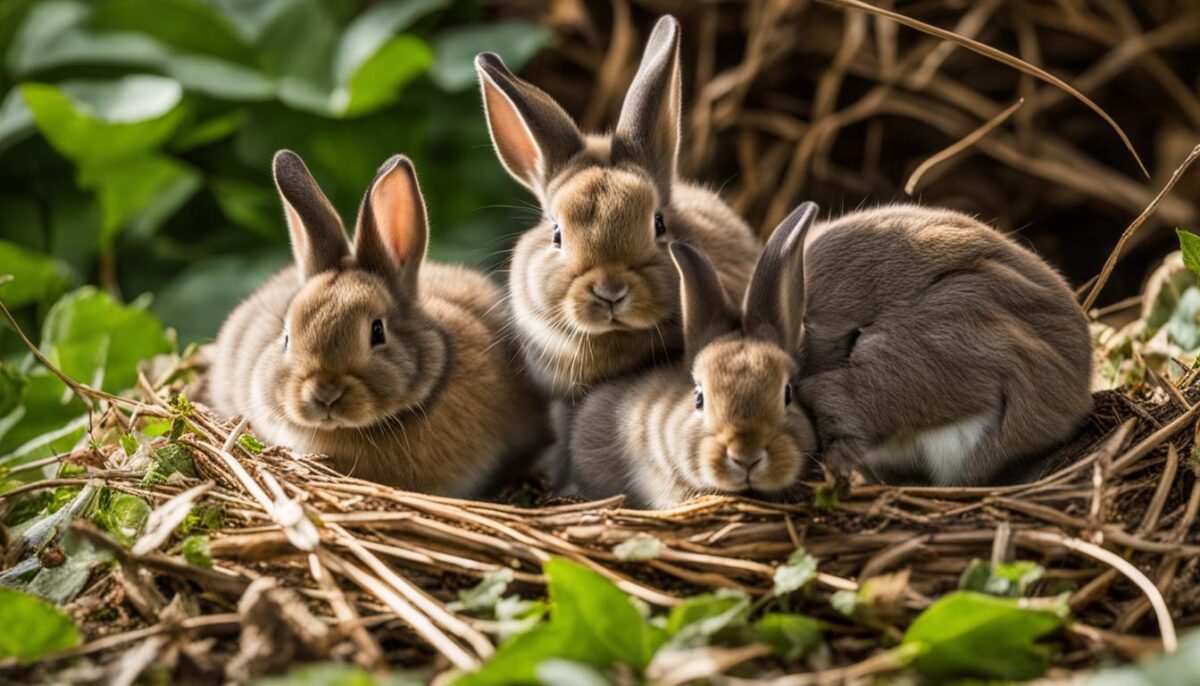
Table: Milestones in the Development of Baby Rabbits
| Milestone | Age |
|---|---|
| Leaving the nest | 12 to 16 days old |
| Starting to eat solid food | 4 to 8 weeks old |
| Developing social skills | 4 to 8 weeks old |
| Refining survival skills | Ongoing |
Conclusion
In conclusion, baby bunnies are born without fur, but they quickly develop it within a few weeks after birth. This process of fur development is essential for their survival, as it provides them with the necessary warmth and protection. The mother rabbit’s role in nest building, maintaining the nest, and caring for her kits is vital in ensuring their well-being during this vulnerable period.
Understanding the natural processes of bunny birth and fur growth allows us to appreciate the intricate journey of these adorable creatures. From their hairless state at birth to the gradual development of their full coat, every step is significant in their growth and adaptation. The mortality rate of newborn rabbits is relatively high, highlighting the importance of the mother rabbit’s care and the development of their fur for their survival.
Next time you come across a nest of baby rabbits, remember to leave them undisturbed. Touching or moving them can disrupt the mother’s care and potentially lead to abandonment. Observing these remarkable creatures from a distance allows us to admire their resilience and natural instincts. The journey from furless newborns to self-sufficient young bunnies is truly remarkable.
FAQ
Are baby rabbits born with fur?
No, baby rabbits are born without fur. Their fur starts to grow within the first few days after birth.
How long does it take for baby rabbits to develop a full coat of fur?
It usually takes a few weeks for baby rabbits to develop a full coat of fur.
What role do female rabbits play in the nest-building process?
Female rabbits, known as does, dig nests in the ground and line them with vegetation to create a safe and warm environment for their kits.
Why do mother rabbits use their fur in nest building?
Mother rabbits pluck fur from various parts of their bodies (except for the abdomen) and use it to create a warm and cozy bed for their kits. The fur acts as insulation, providing necessary warmth and protection.
How long is the nest used for?
The nest is used for about two weeks until the baby rabbits can survive on their own.
What factors contribute to the mortality rate of newborn rabbits?
Factors such as exposure, starvation, drowning, and disease contribute to the mortality rate of newborn rabbits.
Why do mother rabbits stay away from their kits after giving birth?
Mother rabbits practice an absentee-maternal care system to protect the offspring from predators. They leave the nest and return infrequently to avoid attracting attention.
Is it okay to handle or disturb baby rabbits?
It is best to leave baby rabbits alone and avoid unnecessary handling or disturbance. Touching or moving them can disrupt the mother’s care and potentially lead to abandonment.
At what age do baby rabbits start to explore their surroundings?
Baby rabbits leave the nest and start to explore their surroundings at around 12 to 16 days old.
When do baby rabbits become more independent?
Baby rabbits become more independent after being weaned at around 4 to 8 weeks old. They start to eat solid food and transition to self-sufficiency.
What is the significance of understanding bunny birth and fur growth?
Understanding the natural processes of bunny birth and fur growth helps us appreciate the intricate journey of these adorable creatures.


